Accepted Scientific Name: Geohintonia mexicana Glass & W.A.Fitz Maur.
Cact. Suc. Mex. 37: 17 (-19; figs). 1992
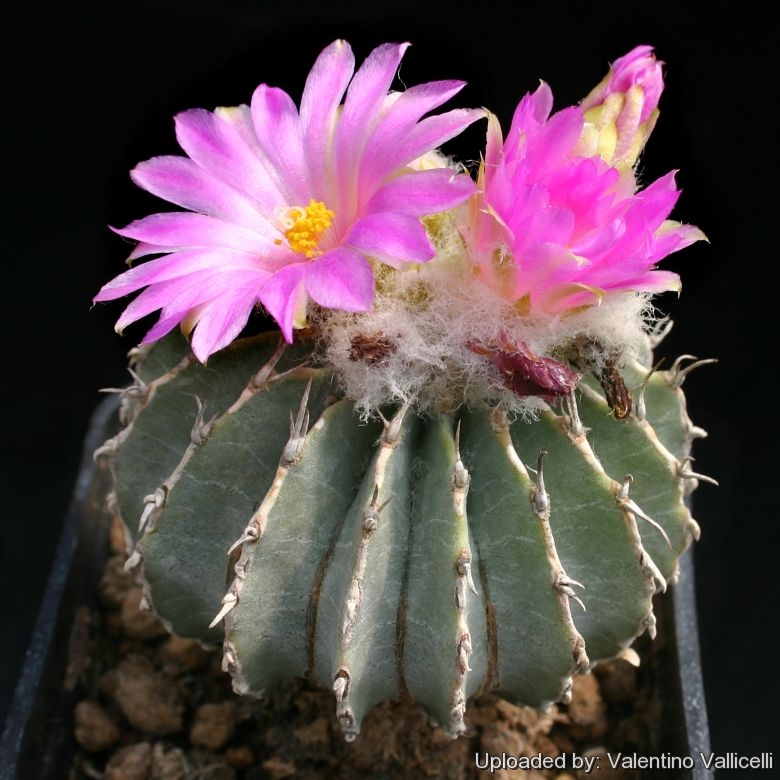
Echinocactus mexicanus (Geohintonia mexicana) Photo by: Valentino Vallicelli
This odd cactus is unmistakable and very distinctive. The flowers are magenta, diurnal and apical.
Origin and Habitat: Mexico (Nuevo León: Sierra Madre). This species has an extremely small range (extent of occurrence and area of occupancy is about 25 km²). The area is essentially a single location. The estimates in population size vary considerably, with 100,000 being an agreed lower limit and perhaps over one million the upper limit.
Altitude range: It occurs at elevations of 1,200 m
Habitat and Ecology: This plant grows on gypsum hills on vertical cliff in the neighbourhood of Rayones, it is a soil specialist - a gypsophile. Now this plant is endangered, the wild population of Gehintonia mexicana was partially wiped out by "collectors". However, the population is extremely large and the collecting does not seem to be causing population declines at a rate sufficient to qualify for a threat category. Illegal collection is the main threat, however, now it is protected by the local population. The local population is safeguarding the species in order to sell it themselves.
Synonyms:
See all synonyms of Geohintonia mexicana
Description: Geohintonia is a monospecific genus discovered in 1992. It is a strongly ribbed cactus of unique appearance.
Stems: Usually solitary, dark green/brown covered by a glaucous/grey pruina, globose becoming slowly columnar, up to 10 cm or more, 10 cm in diameter with a woolly apex.
Ribs: Numerous (18-20) and well distinct.
Areoles: Large, discrete, at first with long wool, later nearly naked.
Spines: Few, very short (3 to 15 mm), triangular, curved, flatened and corky, soon papery a brittle deciduous. Easily detached from the base.
Flowers: 2 x2-4 cm, rich pink to magenta and open during the day; they are born in on top of the plant. Pericarpel and lower part of the tube naked, white. Upper part of the tube with small acute scale, with densely hairy axil bearing 1 cm long white bristles. Stigma 5-6 mm long, yellowish white.
Blooming season: Flowers intermittently throughout the warm months from spring to autumn.
Fruits: Hidden in apical wool, ovoidal (approx 9x4-5 mm), thin walled, pale, drying and breaking off below the middle.
Seeds: Oval, 1,2x0,7 mm, black brown, shiny, relief flat to low-domed. The hilum is large, basal and superficial.
Subspecies, varieties, forms and cultivars of plants belonging to the Geohintonia mexicana group
 Geohintonia mexicana Glass & W.A.Fitz Maur.: It is a strongly ribbed cactus of unique appearance. The stem is dark green/brown covered by a glaucous/grey pruina, globose, becoming slowly columnar, up to 10 cm or more, 10 cm in diameter with a woolly apex.
Geohintonia mexicana Glass & W.A.Fitz Maur.: It is a strongly ribbed cactus of unique appearance. The stem is dark green/brown covered by a glaucous/grey pruina, globose, becoming slowly columnar, up to 10 cm or more, 10 cm in diameter with a woolly apex. Geohintonia mexicana f. cristata hort.: Fan shaped crests of variable appearance and size (depending on clones), the more common type has thin ribs and colourful brown-orangish dark bodies, while the thick greyish-green bodied forms (usually by seeds) are very rare.
Geohintonia mexicana f. cristata hort.: Fan shaped crests of variable appearance and size (depending on clones), the more common type has thin ribs and colourful brown-orangish dark bodies, while the thick greyish-green bodied forms (usually by seeds) are very rare.
Notes: The Aztekium Clade (consisting of Aztekium and Geohintonia) represents a relictual, yet highly specialized lineage forming a sister group to the remaining taxa of the tribe Cacteae. It is suggested that Geohintonia may represent an intergeneric hybrid involving Aztekium (probably A. hintonii which is sympatric with Geohintonia ) and possibly Echinocactus horizonthaloniusSN|1711]]SN|1711]].
Bibliography: Major references and further lectures
1) Edward Anderson “The Cactus family” Timber Press, Incorporated, 2001
2) James Cullen, Sabina G. Knees, H. Suzanne Cubey "The European Garden Flora Flowering Plants: A Manual for the Identification of Plants Cultivated in Europe, Both Out-of-Doors and Under Glass" Cambridge University Press, 11/Aug/2011
3) David R Hunt; Nigel P Taylor; Graham Charles; International Cactaceae Systematics Group. "The New Cactus Lexicon" dh books, 2006
4) Urs Eggli, Leonard E. Newton: “Etymological Dictionary of Succulent Plant Names” Springer, Berlin/Heidelberg 2010
6) Fitz Maurice, B, Fitz Maurice, W.A., Hernández, H.M., Sotomayor, M. & Smith, M. 2013. "Geohintonia mexicana." The IUCN Red List of Threatened Species. Version 2014.3. <www.iucnredlist.org>. Downloaded on 14 December 2014.
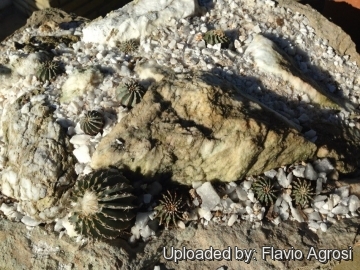 Grown on a slab of gypsum (a sedimentary rock formations) (Geohintonia mexicana) Photo by: Flavio Agrosi
Grown on a slab of gypsum (a sedimentary rock formations) (Geohintonia mexicana) Photo by: Flavio Agrosi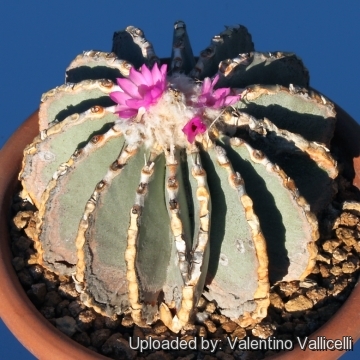 Echinocactus mexicanus (Geohintonia mexicana) Photo by: Valentino Vallicelli
Echinocactus mexicanus (Geohintonia mexicana) Photo by: Valentino Vallicelli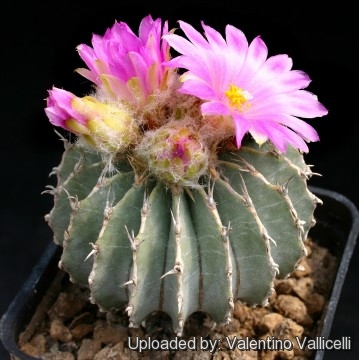 Echinocactus mexicanus (Geohintonia mexicana) Photo by: Valentino Vallicelli
Echinocactus mexicanus (Geohintonia mexicana) Photo by: Valentino Vallicelli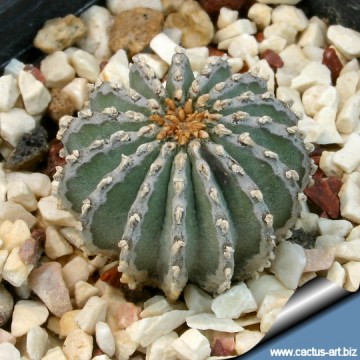 2,5 cm (9 ears old) (Geohintonia mexicana) Photo by: Cactus Art
2,5 cm (9 ears old) (Geohintonia mexicana) Photo by: Cactus Art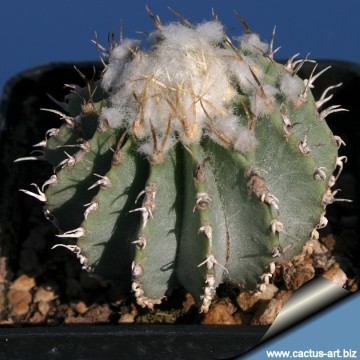 Echinocactus mexicanus (Geohintonia mexicana) Photo by: Cactus Art
Echinocactus mexicanus (Geohintonia mexicana) Photo by: Cactus Art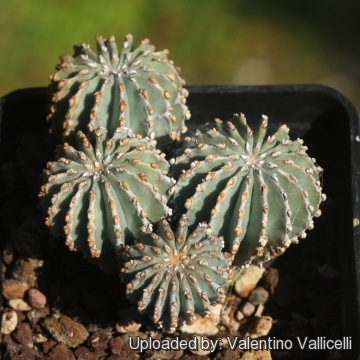 Echinocactus mexicanus (Geohintonia mexicana) Photo by: Valentino Vallicelli
Echinocactus mexicanus (Geohintonia mexicana) Photo by: Valentino Vallicelli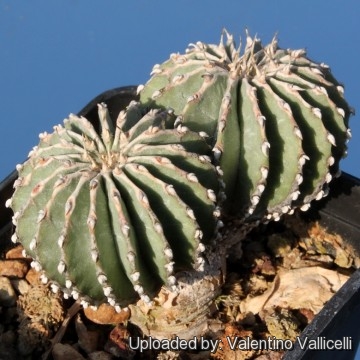 Echinocactus mexicanus (Geohintonia mexicana) Photo by: Valentino Vallicelli
Echinocactus mexicanus (Geohintonia mexicana) Photo by: Valentino Vallicelli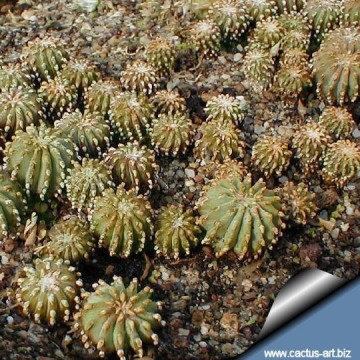 5 years old seedlings. (Geohintonia mexicana) Photo by: Cactus Art
5 years old seedlings. (Geohintonia mexicana) Photo by: Cactus ArtCultivation and Propagation: Although regarded as a choice and difficult plant in cultivation it is relatively easy to grow, but very slow growing. It is often seen as a grafted plant but grows very well on its own roots too. Needs a very well drained mineral substratum with little organic matter (peat, humus). Requires strong sun to part sun to develop good compact growth and waterings should be rather infrequent, to keep the plant flat shaped and not become excessively elongated and unnatural in appearance. Use Water sparingly from March till October and keep perfectly dry in winter, or when night temperatures remain below 10° C (but some people give this plant a light monthly watering to prevent the drying and shedding of the lower tubercles.) It is hardy to -4°C (or less) for a short period. In the rest period no high atmospheric humidity!! Ensure a good ventilation.
Propagation: : Almost exclusively by seeds. But the seedlings are tiny and very slow growing (reach 2 cm of diameter in 6/8 years) and require very careful watering, plants need 10 to 15 years to reach the flowering size.
Sometime, older specimens may shoot tillers from under tubercles, so they can be propagated by cuttings in spring (but rooting may prove a challenge). Plants are sometimes grafted onto column-shaped cacti, which is a much easier way of propagation than sowing.
Your Photos

by Valentino Vallicelli
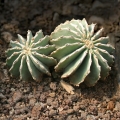
by Valentino Vallicelli
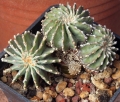
by Valentino Vallicelli

by Valentino Vallicelli

by Valentino Vallicelli
























